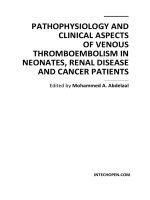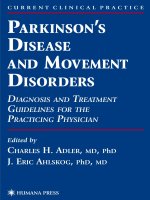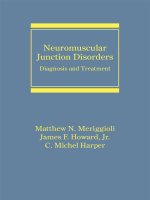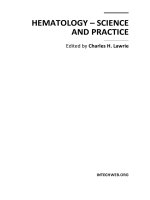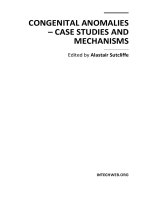Constipation – Causes, Diagnosis and Treatment Edited by Anthony G. Catto-Smith ppt
Bạn đang xem bản rút gọn của tài liệu. Xem và tải ngay bản đầy đủ của tài liệu tại đây (6.63 MB, 186 trang )
CONSTIPATION –
CAUSES, DIAGNOSIS
AND TREATMENT
Edited by Anthony G. Catto-Smith
Constipation – Causes, Diagnosis and Treatment
Edited by Anthony G. Catto-Smith
Published by InTech
Janeza Trdine 9, 51000 Rijeka, Croatia
Copyright © 2012 InTech
All chapters are Open Access distributed under the Creative Commons Attribution 3.0
license, which allows users to download, copy and build upon published articles even for
commercial purposes, as long as the author and publisher are properly credited, which
ensures maximum dissemination and a wider impact of our publications. After this work
has been published by InTech, authors have the right to republish it, in whole or part, in
any publication of which they are the author, and to make other personal use of the
work. Any republication, referencing or personal use of the work must explicitly identify
the original source.
As for readers, this license allows users to download, copy and build upon published
chapters even for commercial purposes, as long as the author and publisher are properly
credited, which ensures maximum dissemination and a wider impact of our publications.
Notice
Statements and opinions expressed in the chapters are these of the individual contributors
and not necessarily those of the editors or publisher. No responsibility is accepted for the
accuracy of information contained in the published chapters. The publisher assumes no
responsibility for any damage or injury to persons or property arising out of the use of any
materials, instructions, methods or ideas contained in the book.
Publishing Process Manager Martina Blecic
Technical Editor Teodora Smiljanic
Cover Designer InTech Design Team
First published March, 2012
Printed in Croatia
A free online edition of this book is available at www.intechopen.com
Additional hard copies can be obtained from
Constipation – Causes, Diagnosis and Treatment, Edited by Anthony G. Catto-Smith
p. cm.
ISBN 978-953-51-0237-3
Contents
Preface IX
Chapter 1 Diagnostic Approach to
Constipation
in Children 1
Kathleen H. McGrath and Patrina Caldwell
Chapter 2 The Role of Diagnostic Tests in Constipation in Children 19
Anthony G. Catto-Smith and Kathleen H. McGrath
Chapter 3 The Role of Interstitial Cells of Cajal (ICC)
in Gastrointestinal Motility Disorders –
What the Gastroenterologist Has to Know 33
Christian Breuer
Chapter 4 Skipping Breakfast is Associated
with Constipation in Post-Adolescent
Female College Students in Japan 47
Tomoko Fujiwara
Chapter 5 Irritable Bowel Syndrome and Constipation 55
Brian C. Dobson
Chapter 6 Opioid Induced Constipation 81
Caterina Aurilio, Maria Caterina Pace,
Vincenzo Pota and Pasquale Sansone
Chapter 7 Drugs in Development
for Opioid-Induced Constipation 89
Kelly S. Sprawls, Egilius L.H. Spierings and Dustin Tran
Chapter 8 Constipation Treatment in Neurological Disorders 99
Gallelli Luca, Pirritano Domenico,
Palleria Caterina and De Sarro Giovambattista
Chapter 9 Bowel Dysfunction in Persons
with Multiple Sclerosis 117
Elsie E. Gulick and Marie Namey
VI Contents
Chapter 10 Multimodal Treatment of Constipation:
Surgery, Rehabilitation or Both? 139
Luigi Brusciano, Crescenzo Di Stazio, Paolo Limongelli,
Gian Mattia Del Genio, Salvatore Tolone, Saverio Sansone,
Francesco Lucido, Ignazio Verde, Antonio D’Alessandro,
Roberto Ruggiero, Simona Gili, Assia Topatino, Vincenzo Amoroso,
Pina Casalino, Giovanni Docimo and Ludovico Docimo
Chapter 11 Core Aspects of Clinical Development
and Trials in Chronic Idiopathic Constipation 147
M. Scott Harris and Oranee T. Daniels
Preface
Constipation is common in both adults and children. Estimates would suggest a
median prevalence of around 12-16% in the general population.
1
While regarded as a
minor nuisance in some cases, its consequences can be severe, with a substantial
impact on quality of life.
2
Secondary faecal soiling has a profound psychological effect
at all ages.
This book provides specific contributions which clarify the pathogenesis, diagnosis, and
therapy of constipation for the general population and also for certain high risk groups.
Surprisingly, consensus definitions of constipation have been hard to achieve, but that
achieved by the PACCT group
3
for children included having at least 2 of the following
features within the last 8 weeks:
Fewer than 3 bowel movements per week
More than one episode of fecal incontinence per week
Large stools in the rectum or palpable on abdominal examination
Passing of stools so large that they obstruct the toilet
Retentive posturing and withholding behavior
Painful defecation.
Importantly, it may not be recognised, only coming to attention because of abdominal
pain, soiling or behavioural disturbances. The chapter by Kathleen McGrath critically
examines the impact defaecation disorders have in children and the diagnostic criteria
used to identify them.
Defaecation disorders are also much more prevalent in certain groups. The very young
and the elderly
4, 5
are at particular risk. They also pose a particular difficulty for both
children and adults with developmental disabilities
6
, neurological dysfunction and
spinal cord injury.
7
Medical and surgical therapy may also lead to constipation
through the use of potent analgesics such as opiods. The chapters by Caterina Aurilio
and Kelly Sprawls provide insights into the aetiology of opiod-induced constipation
and pharmaceutical approaches to avoiding it and its therapy. Occasionally,
constipation may be the presenting feature of another condition such as thyroid
disease or colorectal malignancy.
8
The relationship between colorectal tumors and
colonoscopy is addressed in the chapter by Brusciano. The chapters by Luca Galleli
X Preface
and Elsie Gulick provide insights into the impact of the broad spectrum of
neurological disorders and multiple sclerosis respectively on colorectal dysfunction.
In most situations, constipation occurs in otherwise well individuals. The pathogenesis
in these cases is usually proposed to be inadequate dietary fibre, a sedentary lifestyle,
or poor toileting techniques. The chapter by Tomoko Fujiwara provides an insightful
and unique window into the impact of the all too common habit of skipping breakfast
on bowel function.
Diagnosis is usually straightforward, but it often helpful to make reference to
diagnostic criteria such as that achieved by the PACCT group. Further diagnostic
testing is not usually required, but can be invaluable in specific instances. The chapter
on diagnostic tests (Catto-Smith et al.) provides a review of the available testing
techniques. While abdominal radiography is often employed, it is rarely adds much.
Studies of colorectal motility
9, 10
provide an immense amount of information but are
either expensive, invasive, or difficult to interpret
11
. However, they have enabled a
better understanding of the motility dysfunction responsible for constipation.
12
Sensory dysfunction is clearly important as many patients are unaware of the extent of
rectal filling.
13
These type of studies have however meant that entities such as slow
transit constipation, anorectal incoordination, sphincteric dysfunction and the basis for
constipation in irritable bowel syndrome are now much better understood
14
. The
chapter by Brian Dobson provides a novel hypothesis into the pathogenesis of
defaecation disorders in irritable bowel syndrome.
In many situations, otherwise uncomplicated constipation will respond to simple
interventions such as attention to diet
15
and toileting, but in other patients it can be
extraordinarily difficult to achieve therapeutic success. Medications generally function
through either assisting colorectal contractility or softening the stool.
16
Unfortunately,
drugs only offer temporary relief if the primary cause is unable to be improved. Recent
interest has centred on possibly dysbiotic colonic flora in the hope that probiotics
17
may be helpful. There are a variety of traditional and complementary medications that
are used widely in the community.
18
Behavioural therapies are often very effective in children,
19, 20
and biofeedback
modalities have attracted a great deal of interest, particularly in adults.
21
Better understanding of the pathophysiology of defaecation disorders has opened the
doors to novel treatments. Abnormalities in the excitatory cells primarily responsible
controlling gastrointestinal motility have been postulated to have a major role in
certain types of constipation such as slow transit
22
and even that associated with
diabetes.
23
The chapter by Christian Breuer provides a good understanding of the
Interstitial Cell of Cajal – a central player in gastrointestinal dysmotility and slow
transit constipation. Sacral stimulation is certainly effective, but is invasive. A very
exciting new area is that of transabdominal electrical stimulation,
24
which appears to
offer the unenviable combination of low cost, ease of use, durability of effect to an
otherwise treatment-resistant population.
25, 26
Preface XI
It goes without saying that the introduction of any new therapy must be accompanied
by careful evaluation. The chapter by Scott Harris provides a careful and clear
description of the core aspects of clinical development and trials of a range of
therapeutic modalities in chronic idiopathic constipation.
Anthony G. Catto-Smith
The Royal Children’s Hospital, Melbourne,
Australia
References
[1] Mugie SM, Benninga MA, Di Lorenzo C. Epidemiology of constipation in children
and adults: a systematic review. Best Practice & Research in Clinical
Gastroenterology 2011;25:3-18.
[2] Wald A, Sigurdsson L. Quality of life in children and adults with constipation. Best
Practice & Research in Clinical Gastroenterology 2011;25:19-27.
[3] Benninga M, Candy DC, Catto-Smith AG, Clayden G, Loening-Baucke V, Di
Lorenzo C, Nurko S, Staiano A. The Paris Consensus on Childhood
Constipation Terminology (PACCT) Group. J Pediatr Gastroenterol Nutr
2005;40:273-5.
[4] McCrea GL, Miaskowski C, Stotts NA, Macera L, Varma MG. A review of the
literature on gender and age differences in the prevalence and characteristics
of constipation in North America. Journal of Pain & Symptom Management
2009;37:737-45.
[5] Gallagher P, O'Mahony D. Constipation in old age. Best Practice & Research in
Clinical Gastroenterology 2009;23:875-87.
[6] Matson JL, LoVullo SV. Encopresis, soiling and constipation in children and adults
with developmental disability. Research in Developmental Disabilities
2009;30:799-807.
[7] Lynch AC, Anthony A, Dobbs BR, Frizelle FA. Anorectal physiology following
spinal cord injury. Spinal Cord 2000;38:573-80.
[8] Astin M, Griffin T, Neal RD, Rose P, Hamilton W. The diagnostic value of
symptoms for colorectal cancer in primary care: a systematic review. British
Journal of General Practice 2011;61:e231-43.
[9] Southwell BR, Clarke MC, Sutcliffe J, Hutson JM. Colonic transit studies: normal
values for adults and children with comparison of radiological and
scintigraphic methods. Pediatric Surgery International 2009;25:559-72.
[10] Dinning PG, Benninga MA, Southwell BR, Scott SM. Paediatric and adult colonic
manometry: a tool to help unravel the pathophysiology of constipation.
World Journal of Gastroenterology 2010;16:5162-72.
[11] Quigley EM. What we have learned about colonic motility: normal and
disturbed. Current Opinion in Gastroenterology 2010;26:53-60.
XII Preface
[12] King SK, Catto-Smith AG, Stanton MP, Sutcliffe JR, Simpson D, Cook I, Dinning
P, Hutson JM, Southwell BR. 24-Hour colonic manometry in pediatric slow
transit constipation shows significant reductions in antegrade propagation.
American Journal of Gastroenterology 2008;103:2083-91.
[13] Scott SM, van den Berg MM, Benninga MA. Rectal sensorimotor dysfunction in
constipation. Best Practice & Research in Clinical Gastroenterology
2011;25:103-18.
[14] Dinning PG, Di Lorenzo C. Colonic dysmotility in constipation. Best Practice &
Research in Clinical Gastroenterology 2011;25:89-101.
[15] Suares NC, Ford AC. Systematic review: the effects of fibre in the management of
chronic idiopathic constipation. Alimentary Pharmacology & Therapeutics
2011;33:895-901.
[16] Ford AC, Suares NC. Effect of laxatives and pharmacological therapies in chronic
idiopathic constipation: systematic review and meta-analysis. Gut
2011;60:209-18.
[17] Chmielewska A, Szajewska H. Systematic review of randomised controlled trials:
probiotics for functional constipation. World Journal of Gastroenterology
2010;16:69-75.
[18] Cheng CW, Bian ZX, Wu TX. Systematic review of Chinese herbal medicine for
functional constipation. World Journal of Gastroenterology 2009;15:4886-95.
[19] Catto-Smith AG. 5. Constipation and toileting issues in children. Med J Aust
2005;182:242-6.
[20] Whitehead WE, di Lorenzo C, Leroi AM, Porrett T, Rao SS. Conservative and
behavioural management of constipation. Neurogastroenterology & Motility
2009;21 Suppl 2:55-61.
[21] Koh CE, Young CJ, Young JM, Solomon MJ. Systematic review of randomized
controlled trials of the effectiveness of biofeedback for pelvic floor
dysfunction. British Journal of Surgery 2008;95:1079-87.
[22] Sutcliffe J, King SK, Clarke MC, Farmer P, Hutson JM, Southwell BR. Reduced
distribution of pacemaking cells in dilated colon. Pediatric Surgery
International 2007;23:1179-82.
[23] Southwell BR, Southwell BR. Loss of interstitial cells of Cajal may be central to
poor intestinal motility in diabetes mellitus. Journal of Gastroenterology &
Hepatology 2008;23:505-7.
[24] van Wunnik BP, Baeten CG, Southwell BR. Neuromodulation for constipation:
sacral and transcutaneous stimulation. Best Practice & Research in Clinical
Gastroenterology 2011;25:181-91.
[25] Ismail KA, Chase J, Gibb S, Clarke M, Catto-Smith AG, Robertson VJ, Hutson JM,
Southwell BR. Daily transabdominal electrical stimulation at home increased
defecation in children with slow-transit constipation: a pilot study. Journal of
Pediatric Surgery 2009;44:2388-92.
[26] Clarke MC, Chase JW, Gibb S, Robertson VJ, Catto-Smith A, Hutson JM,
Southwell BR. Decreased colonic transit time after transcutaneous
interferential electrical stimulation in children with slow transit constipation.
Journal of Pediatric Surgery 2009;44:408-12.
1
Diagnostic Approach to
Constipation
in Children
Kathleen H. McGrath
1
and Patrina Caldwell
2
1
The Royal Children’s Hospital, Melbourne
2
University of Sydney, The Children’s Hospital at Westmead, Sydney
Australia
1. Introduction
Constipation is a common paediatric problem. It is relevant to the practice of both general
paediatricians and paediatric gastroenterologists and accounts for 3% and 25% of outpatient
visits respectively (Levine, 1975; Taitz et al., 1986). International prevalence rates range from
0.7% to 29.6% which is similar for males and females (van den Berg et al., 2006). The broad
range of reported prevalence is related to differing criteria for defining constipation but may
also reflect genuine differences between ethnic populations and socioeconomic influences.
The diagnosis of constipation is historically a subjective and symptom-based approach. It
relies on good clinical history taking and physical examination, in particular to exclude an
underlying organic aetiology. In order to objectify the classification of this entity and allow
for comparison of data between studies (e.g. prevalence rates, treatment outcomes), a
number of diagnostic classifications have been proposed. This chapter will discuss the origin
of these various classifications, their application and role within paediatric clinical practice
and research. It will also provide a suggested clinical approach to the diagnosis of
constipation in children, including the problems that may be encountered.
2. Importance of the appropriate diagnosis of constipation in children
Symptoms of childhood constipation may vary from mild and short-lived to severe and
chronic. It can affect children in all age groups from infants to adolescents and can extend
into adulthood.
Constipation is associated with a wide range of consequences for the individual child. These
include physical pain and discomfort, psychological distress (primarily related to faecal
incontinence) and an increased risk of urinary dysfunction. It can also impact on quality of
life, family dynamics and socialisation through missed days of school and work (Belsey et
al., 2010). In some children, a delayed or missed diagnosis can result in progression towards
a significant chronic health problem with physical, psychological and social implications.
2.1 Impact on the child: Physical discomfort associated with constipation
Constipation is associated with varying degrees of physical discomfort for children. The
onset of constipation is often related to experience(s) of painful defaecation. This may be
caused by the presence of an anal fissure, perianal infection or perianal inflammation due to
Constipation – Causes, Diagnosis and Treatment
2
cow’s milk protein intolerance or other underlying medical conditions. Once children
experience discomfort, they commonly associate the process of defaecation with pain and
actively attempt to avoid it. This may manifest as toilet refusal or stool withholding
behaviours where there is voluntary contraction of the external anal sphincter with the urge
to defaecate.
Repetitive withholding behaviours result in further constipation as the brain begins to
ignore the signals that would usually alert the child to the need to defaecate (Weaver &
Dobson, 2007). This results in stools that are hard, large and difficult to pass which can lead
to further experiences of pain and the development of perianal tears, perpetuating the cycle
of painful defaecation, stool withholding and worsening constipation.
Constipation is one of the most frequent causes for abdominal pain in children presenting to
their medical practitioner or the emergency department. One study found that acute or
chronic constipation accounted for 48% of children with acute abdominal pain presenting to
a large academic paediatric primary care population (Loening-Baucke & Swidsinski, 2007).
Ongoing chronic constipation results in stool impaction, distension of the rectum and
sigmoid colon and rectal insensitivity. Stool impaction can cause abdominal pain which may
vary from mild to severe in nature. Children with constipation may also experience systemic
symptoms including loss of appetite, nausea, vomiting and weight loss.
2.2 Impact on the child: Chronic constipation and quality of life
Constipation can affect a child’s physical and mental wellbeing and impact on their overall
quality of life. Section 2.1 described the common physical manifestations of constipation
including pain.
Studies have further assessed the impact of chronic constipation on a child’s emotional
status. One Australian study assessed a cohort of children with slow transit constipation
(confirmed on radioisotope study) and compared them with a group of healthy children
with normal bowel patterns. The study found that children with constipation reported a
significantly lower quality of life (assessed by questionnaires addressing domains of
physical, emotional, social and school functioning) compared with the non-constipated
children. In addition, the parents of these children reported a significantly lower quality of
life for their child than the child’s self-reporting using the same scoring system (Clarke et al,
2008). Constipation not only affects the individual child’s quality of life, but may impact on
their relationship with parents and / or siblings and the family dynamics as a whole.
Another study compared children with constipation to groups of children with inflammatory
bowel disease, gastro-oesophageal reflux disease or normal health. They found that children
with constipation reported a significantly lower quality of life (assessed by self and parental
reporting) compared with both healthy children and children with inflammatory bowel
disease or gastro-oesophageal reflux disease (Youssef et al., 2005). This was a pertinent finding
considering that inflammatory bowel disease is traditionally accepted by physicians and the
general population as being a more serious condition than constipation.
A recent systematic review by Belsey and colleagues demonstrated that impaired quality of
life is a consistent finding in children and adults with chronic constipation. They found that
the quality of life in children with chronic constipation was comparable to those of children
Diagnostic Approach to Constipation in Children
3
with other chronic conditions traditionally regarded as being more serious, including
cardiac and rheumatologic diseases (Belsey et al., 2010).
The diagnosis of chronic constipation in children should be taken seriously as its impact on
quality of life may be far greater than initially anticipated. It should be considered a public
health issue for primary physicians, paediatricians and paediatric gastroenterologists.
Further studies are needed to specifically assess the impact of this condition on quality of
life when it lasts from childhood into adulthood.
2.3 Impact on the child: Faecal incontinence and psychological distress
Faecal incontinence refers to the passage of stools in an inappropriate place (Benninga et al.,
2005). It occurs in 1-3% of children and can affect up to 8% of adults (Catto-Smith, 2005).
Faecal incontinence is a frequent accompanying symptom of childhood constipation. Studies
show that it is present in up to 84% of children with constipation (Vooskijl et al., 2004). In
around 80% of cases of faecal incontinence, it is involuntary and occurs in the setting of
chronic constipation (constipation-associated faecal incontinence) (Joinson et al., 2006). Less
commonly faecal incontinence can be voluntary (non-retentive faecal incontinence) and may
be related to emotional disturbance with no evidence of constipation being present.
Functional constipation and stool withholding behaviours lead to impaction of faeces in the
rectum, distension of the rectum and sigmoid colon and rectal insensitivity which may
result in faecal incontinence. Due to rectal insensitivity, children may not be aware of this
happening. Risk factors for faecal incontinence are listed in Table 1.
Faecal incontinence is associated with behavioural and emotional problems in children. A
recent population study of over 8000 children found significantly higher rates of
behavioural and emotional problems in children with faecal incontinence compared to those
without. In addition they noted that these problems were significantly greater in children
who soiled frequently compared with those who soiled only occasionally (less than once per
week) (Joinson et al., 2006).
Children may be embarrassed by their faecal incontinence, associated body odour and
differences from their peers. This is particularly the case for school-aged children who may
Risk factor Other related factors
Chronic constipation Low dietary fibre and fluid intake
Cow’s milk protein intolerance
Poor toilet posture and incomplete evacuation
Medical conditions (hypothyroidism,
hypercalcaemia, hypokalaemia)
Medications
Toilet refusal Previous painful defaecation
Commencement of school
Psychological factors Autistic spectrum disorders
Attention deficit hyperactivity disorder
Significant emotional life events
Table 1. Risk factors for faecal incontinence (modified from Ho & Caldwell, 2008).
Constipation – Causes, Diagnosis and Treatment
4
experience teasing or bullying and social isolation. Constant focus on the child’s bowel
habits from the parents may distress the child and cause conflict within the home between
family members. Parents may wrongly ‘blame’ the child for being ‘lazy’ and punish them
unnecessarily, causing further emotional distress. The child’s degree of distress and low self-
esteem may affect their behaviour and cause them to become withdrawn or alternatively
‘act up’. There may be considerable negative implications on their learning and performance
at school. Further consequences may include missed days of school and work for parents,
leading to societal costs on a wider scale.
2.4 Impact on the child: Urinary dysfunction
Epidemiological studies have identified an association between constipation and certain
urological conditions. These include urinary incontinence, vesicoureteric reflux and urinary
tract infections (McGrath & Caldwell, 2008; Loening-Baucke, 1997; O’Regan et al., 1985,
1986). Loening-Baucke assessed 234 children with chronic constipation and found that 29%
had daytime urinary incontinence and 11% had a urinary tract infection. A more recent
Australian study found a prevalence of constipation of 36.1% in a population of children
with nocturnal enuresis (McGrath & Caldwell, 2008), which is higher than reported
international prevalence rates of 0.7% to 29.6% in the normal population.
With successful treatment of constipation, many of these urinary symptoms will resolve. In
one study, successful treatment of constipation after 12 months resulted in resolution of
daytime urinary incontinence in 89% and urinary tract infection in all patients with normal
urinary tract anatomy (Loening-Baucke, 1997).
2.5 Impact on the child: Outcome of late or missed diagnosis
A timely diagnosis of constipation can help to prevent or minimise many of the
complications outlined above. If constipation is identified early, management can be
initiated in the form of education, toileting programs, dietary modification, behavioural
therapy and laxatives. Successful intervention to ‘keep the rectum empty’ will avoid
progression to stool impaction, rectal distension and insensitivity and the onset of faecal
incontinence. In addition, the early identification and management of constipation has been
shown to result in better treatment response and outcomes (Van Ginkel et al., 2003). This
was particularly the case when children were referred for management of constipation
under the age of 2 years (Loening-Baucke, 1993).
Missed or delayed diagnosis of constipation can increase the risk of both physical and
psychological complications, making the problem more difficult to manage later on. Where
urinary dysfunction exists in the context of chronic constipation, a missed diagnosis of
constipation may result in treatment failure. An accurate diagnosis of constipation is
paramount for provision of optimal patient care and quality of life.
3. The use of diagnostic criteria in childhood constipation
3.1 Definitions and Historical overview
The term ‘constipation’ derives from the Latin ‘constipare’ meaning to crowd together. The
accepted understanding of constipation describes a constellation of different symptoms
Diagnostic Approach to Constipation in Children
5
related to difficult passage of stool. These may include infrequent passage of stool, firm stool
consistency, straining and painful defaecation, retentive posturing and faecal incontinence.
The subjective nature of these symptoms has historically made defining and diagnosing
constipation a challenge and there is no consensus on the definition for ‘constipation’. This
has limited the ability of researchers to accurately compare different clinical studies in this
field and accounts in part for the wide range of reported international prevalence.
In an attempt to standardise the definition of constipation and the related disorders of
gastrointestinal motility, diagnostic criteria were created. Generally, these separate
functional constipation from that secondary to medical illnesses and medications. They are
outlined below and summarised in Table 2.
Early attempts to formalise a definition of constipation included the Iowa classic criteria.
This classification was used by some groups in clinical research for the last two decades but
its application in clinical practice was sporadic and the mainstream diagnosis of
constipation remained largely subjective.
In 1989, a group of investigators met in Rome to form a consensus opinion to assist in the
diagnosis of functional gastrointestinal disorders (FGID). Initially the group focussed on the
adult population. In 1997, at a consensus conference, the Rome I Criteria were discussed
with relation to childhood, forming the Paediatric Rome II Criteria (published in 1999). Also
in 1997, the Bristol Stool Chart was published as an aid for classification of stool by
appearance and consistency (Lewis & Heaton, 1997) (see Figure 1). Interpretation of these
illustrations was extrapolated to help assist in the diagnosis of constipation (Table 2).
Fig. 1. Bristol stool chart (Lewis and Heaton, 1997).
Constipation – Causes, Diagnosis and Treatment
6
Bristol stool chart (see Fig. 1.)
Constipation indicated by Types 1 and 2
(Types 4 > 3 being the ‘ideal stools’ and Types 5 to 7 tending towards diarrhoea)
(Lewis & Heaton, 1997)
Classic Iowa criteria
Paediatric constipation = at least 2 of the following criteria:
Defecation frequency <3 times per week
Two or more encopresis episodes per week
Periodic passage of very large amounts of stool once every 7 to 30 days (the criterion
of a large amount of stool is satisfied if it is estimated to be twice the standard
amount of stool, shown in a clay model, or is stools are so large that they clog the
toilet).
Solitary encopresis = in a child older than 4 years of age:
Two or more encopresis episodes per week
Defecation frequency ≥3 times per week
No passage of very large amounts of stool
(Loening-Baucke, 1990, as cited in Benninga et al., 2004)
Rome II criteria
Functional constipation: In infants and preschool children (from 1 month to 6 years), at
least 2 weeks of
Scybalous, pebble-like, hard stools in a majority of stools, or
Firm stools 2 or fewer times/week, and
No evidence of structural, endocrine, or metabolic disease
Functional faecal retention: From infancy to 16 years old, a history of at least 12 weeks of
Passage of large-diameter stools at intervals <2 times/week, and
Retentive posturing, avoiding defecation by purposefully contracting the pelvic
floor. As pelvic floor muscles fatigue, the child uses the gluteal muscles, squeezing
the buttocks together.
Functional non-retentive faecal soiling: Once a week or more for the preceding 12 weeks,
in a child over age 4 years, a history of defaecation
In places and at times inappropriate to the social context
In the absence of structural or inflammatory disease, and
In the absence of signs of faecal retention.
(Rasquin-Weber et al., 1999)
Working group report of the first world congress of Paediatric Gastroenterology,
Hepatology, and Nutrition
Constipation is a symptom defined by the occurrence of any of the following,
independent of stool frequency:
Passage of hard, scybalous, pebble-like or cylindrical cracked stools
Straining or painful defecation
Diagnostic Approach to Constipation in Children
7
Passage of large stools that may clog the toilet
Or stool frequency less than 3 per week, unless the child is breast fed.
(H
y
ams et al., 2002)
PACCT criteria
Chronic constipation: Occurrence of 2 or more of the following characteristics during the
preceding 8 weeks:
Fewer than 3 bowel movements per week
More than 1 episode of faecal incontinence/week
Large stools in the rectum or palpable on abdominal examination
Passage of large-diameter stools that may obstruct the toilet
Display of retentive posturing and withholding behaviours
Painful defecation
Faecal incontinence: Passage of stools in an inappropriate place
Organic faecal incontinence: faecal incontinence resulting from organic disease
Functional faecal incontinence: nonorganic disease that can be subdivided into:
- Constipation-associated faecal incontinence: functional faecal incontinence
associated with the presence of constipation
- Non-retentive (non-constipation-associated) faecal incontinence: passage of
stools in an inappropriate place, occurring in children with a mental age of 4
years and older, with no evidence of constipation based on history and/or
examination
(Benninga et al., 2005)
Rome III criteria
Functional constipation: Must include 1 month of at least 2 of the following in infants up
to 4 years of age:
Two or fewer defecations per week
At least 1 episode per week of incontinence after the acquisition of toileting skills
History of excessive stool retention
History of painful or hard bowel movements
Presence of a large faecal mass in the rectum
History of large-diameter stools that may obstruct the toilet
(Hyman et al., 2006)
Functional constipation: Must include 2 or more of the following in a child with a
developmental age of at least 4 years with insufficient criteria for diagnosis of irritable
bowel syndrome:
Two or fewer defecations in the toilet per week
At least 1 episode of faecal incontinence per week
History of retentive posturing or excessive volitional stool retention
History of painful or hard bowel movements
Presence of a large faecal mass in the rectum
History of large-diameter stools that may obstruct the toilet
Criteria must be fulfilled at least once per week for at least 2 months before diagnosis
(Rasquin et al., 2006)
Constipation – Causes, Diagnosis and Treatment
8
Non-retentive faecal incontinence: Must include all of the following in a child with a
developmental age of at least 4 years:
Defecation into places inappropriate to the social context at least once per month
No evidence of an inflammatory, anatomic, metabolic or neoplastic process that
explains the subject’s symptoms
No evidence of faecal retention.
Table 2. Different classification for childhood constipation.
Some paediatric gastroenterologists and paediatricians found the symptom based Paediatric
Rome II Criteria to be too restrictive (see section 3.2). In light of this, a group of experts
(paediatric gastroenterologists and paediatricians) gathered in Paris in 2004 to redefine
working definitions in gastrointestinal motility (The Paris Consensus on Childhood
Constipation Terminology (PACCT) Group). The definition of functional constipation
described by PACCT was published in its own right in 2005.
PACCT also recommended discontinuation of the terms ‘encopresis’ and ‘soiling’ and
replacement by the term ‘faecal incontinence’. Soiling was a term that had often been used
mutually with encopresis but was felt by the PACCT group to be too broad with possible
negative connotations of dirtiness and blame in some cultures. Likewise, the term encopresis
was used widely with variable degrees of interpretation and understanding. Some clinicians
used this term to refer to intentional passage of stool in a socially inappropriate place (often
associated with a psychological disorder). It was thought that discontinuing these two terms
in favour of the more strictly defined ‘faecal incontinence’ would lead to more agreement in
understanding and a greater capacity to properly compare different clinical studies. Faecal
incontinence was defined as passage of stools in an inappropriate place. For the purposes of
this chapter, we will use the term ‘faecal incontinence’ in place of ‘encopresis’ or ‘soiling’,
including where studies were published prior to PACCT in 2005.
PACCT was further used to assist in the development of the Rome III Criteria (published in
2006). The Rome III Criteria addressed previously perceived problems such as age
restriction (infants versus children / adolescents) and retentive posturing as a component
symptom which will be discussed in more detail in Section 3.2.
3.2 Comparison and contrast of diagnostic classifications for constipation
There continues to be varying opinions on the benefits and limitations of the different
diagnostic classifications for constipation. The intention behind their derivation was to
‘objectify’ the ability to diagnose constipation, to allow for comparison between clinical
research studies and to aid in the identification of this common paediatric problem in
clinical practice. Table 3 summarises the various differences and similarities between the
criteria of the classification systems. Below, we have provided a more detailed description of
the comparison and contrast between these classifications.
In order to be useful, a diagnostic classification must be shown to be reliable, valid and
applicable for a range of relevant population groups. There were a few early attempts to
validate the Rome II criteria for functional gastrointestinal disorders. Some studies found
the Rome II criteria were helpful for diagnosing functional gastrointestinal disorders in
Diagnostic Approach to Constipation in Children
9
childhood however these studies were conducted in a tertiary setting, and may not be
generalisable (Miele et al., 2004; Caplan et al., 2005).
Classification
Frequency of
stools
Faecal
incontinence
Large stool size-
rectal or
abdominal exam
Large stool size-
toilet
Stool
withholding /
Retention
Painful
Defaecation
Stool
Consistency
Iowa criteria √ √ - √ - - -
Rome II √ - - - - - √
Working
group
√ - - √ - √ √
PACCT √ √ √ √ √ √ -
Rome III √ √ √ √ √ √ √
Table 3. Comparison of criteria of different classifications for childhood constipation
Since their origin, the Rome II criteria have been widely criticised for being too restrictive.
Studies have compared the diagnosis of constipation by the Rome II criteria with other
classification systems. One study compared the Rome II criteria with the classic Iowa criteria
in identification of constipation in 198 otherwise healthy children referred to a tertiary
centre for defaecation disorders. They found the prevalence of constipation was 69% by the
Rome II criteria and 74% by the classic Iowa criteria (Voskijl et al., 2004). These results
suggest that some children may be missed by the Rome II criteria. A similar study from
Turkey assessing children referred to general paediatric or paediatric gastroenterology units
for constipation found a prevalence of 72.5% by the Iowa criteria compared with 63.7% by
the Rome II criteria (Aydogdu et al., 2009).
One of the main aspects of the Rome II criteria which has restricted its capacity for
identification of constipation in children is its exclusion of faecal incontinence as a criterion.
Faecal incontinence is common and may affect up to 84% of constipated children (Vooskijl et
al., 2004). Exclusion of this relatively frequent symptom may lead to under diagnosis. This
was illustrated in the study by Voskijl et al comparing the Rome II diagnostic criteria with
the classic Iowa criteria. 16% of children diagnosed with constipation by the classic Iowa
criteria did not fulfil the Rome II criteria. These children had low defaecation frequency in
combination with encopresis and / or faecal retention (Voskijl et al., 2004). Faecal
incontinence is not part of the Rome II criteria. This was considered in creation of the
PACCT and Rome III criteria in 2004 and 2006 respectively, with inclusion of ‘faecal
incontinence more than once per week’ as a component criterion for these classifications.
Another group assessed the prevalence of functional defaecation disorders (including
constipation) according to PACCT versus Rome II criteria and attempted to compare their
clinical validity (Boccia et al., 2007). They found that 53 of 126 (42.1%) of children defined as
constipated by PACCT criteria were not recognised by the Rome II criteria, and one child
was diagnosed as constipated by Rome II criteria and not PACCT. Many of the children
missed by Rome II criteria were excluded purely on the basis of its age restrictions (i.e. not
Constipation – Causes, Diagnosis and Treatment
10
between 1 month and 6 years). This criterion excludes all children greater than 6 years old
with constipation regardless of whether they fulfil the other symptom criteria. This
stringency is likely to fail to diagnose constipation in older children and supports previous
opinion that the Rome II criteria are too restrictive.
In 2005, the PACCT criteria attempted to provide an expert consensus on working definitions
in childhood defaecation disorders. The two most pertinent changes were the unification of
‘Rome II functional constipation’ and ‘functional faecal retention’ to ‘chronic constipation’ and
the replacement of the terms ‘soiling’ and ‘encopresis’ with ‘faecal incontinence’. Stool
withholding behaviours or retentive posturing was also included as a new criterion although
some physicians feel these behaviours may be difficult for parents to recognise in their child.
The Rome III criteria are really an extension of the PACCT criteria but with different
duration requirements for different age groups (symptoms for at least 1 month in infants/
children under 4 years old and for at least 2 months in children older than 4 years). With
regard to symptom duration, the reduced requirement from symptoms of 3 months
duration to 1 month (in infants / toddlers) and to 2 months in children greater than 4 years
old/ adolescents was one of the pertinent changes from Rome II to Rome III. This was
particularly important in light of recognition that earlier identification of constipation and
treatment intervention is associated with a better treatment response and outcome.
There are some studies comparing the Rome III and PACCT classifications. Many of these
studies were conducted in populations of children referred to tertiary centres and so their
results may not be generalisable to children in the community. One study from Sri Lanka
which may be more applicable to children in the community compared Rome III and
PACCT criteria for diagnosing constipation among school children aged 10-16 years old.
They performed a cross-sectional survey in 5 classes randomly selected from a semi-urban
school using a validated, self administered questionnaire with guidance from research
assistants. The prevalence of constipation was 10.7% by both the Rome III and PACCT
criteria suggesting a level of agreement between the classifications (Rajindrajith et al., 2009).
One criticism of PACCT has been the exclusion of ‘scybalous, pebble-like stools’ as a
criterion for constipation. Some groups have shown that a high percentage of constipated
children report this symptom and advocate for its inclusion in future diagnostic criteria
(Boccia et al., 2007; Maffei & Morais, 2005). The Rome III classification does not directly refer
to this condition but does have ‘history of painful or hard bowel movements’ as one of its
criteria which may incorporate this criterion. Similarly, straining that is not accompanied by
pain has been suggested for inclusion in future classifications in light of its relatively
frequent reporting in constipated children. One recent study in Sri Lanka identified
straining in 75% of children with constipation (as defined by both the PACCT and Rome III
criteria) (Rajindrajith et al., 2009).
Another criticism of PACCT has been that ‘large faecal mass in the rectum’ (a criteria only
ascertained by physical examination or an abdominal radiograph) may be difficult to assess
in large community surveys (without the involvement of an assessing clinician) (Maffei and
Morais, 2005). There is a strong need to address the applicability and validity of the Rome III
diagnostic classification for constipation in both primary care and community settings.
Some of the above concerns were addressed by the ‘Boston working group’ in their
definition of constipation in children (Hyams et al, 2002) (see Table 2). This is another
Diagnostic Approach to Constipation in Children
11
diagnostic classification which takes into account that not all constipated children may have
infrequent defaecation. It also accounts for the known variation in stool consistency amongst
breastfed infants and wide variant of the norm.
The evolution of these diagnostic classifications reflects the complexities of trying to create a
system that can be easily understood, reliable, applicable to children in both hospital and
community settings and validated by evidence based processes.
4. Challenges associated with the diagnosis of constipation in the paediatric
population
The traditional diagnostic approach centres on a thorough history, detailed examination and
the use of relevant supporting investigations. This can be challenging in paediatrics
requiring utilisation of the ‘art’ of medicine to take a history from both child and parents,
and willingness to modify the examination of the child depending on age and cooperation.
As current definitions of constipation are largely symptom based, the reporting of these
symptoms is influenced by an individual’s perception of ‘the norm’. Studies have shown
that parents and children may have different insight into a child’s symptoms (Caplan et al.,
2005), which may pose a further challenge for clinicians.
4.1 Different insight from parents, clinicians and children
Constipation can be difficult for parents to recognise and they may under-report this
condition in their child. There is a difference between parental and clinician recognition of
constipation.
One study found that parents tended to under-report constipation in their children
(sensitivity 23%) but were good at recognising when their child was not constipated
(specificity 90%) (McGrath & Caldwell, 2008). Although parents were able to identify
individual symptoms of constipation during history taking, they were poor at recognising
that these symptoms signified constipation. Table 4 outlines the recognition of different
symptoms of constipation by parents in this cohort. Parents were more likely to report
constipation with infrequent defecation and presence of faecal incontinence. There was no
significant association between parental reporting of constipation and hard consistency of
stools and the presence of straining during defaecation.
Clinicians should carefully question parents and children about individual symptoms of
constipation rather than relying on parents to recognise that their child is constipated. Other
influential factors that must be addressed in history-taking include whether the child is
toilet trained, the ease of toilet training, how ‘involved’ the parents are in their child’s bowel
hygiene (i.e. do they still require assistance after defaecation with wiping / redressing) and
whether the reporting parent is the primary carer for the child (how much time do they
spend attending to the child’s daily needs). The use of a stool diary may be of value in
improving the reliability of recall of this information.
Despite carefully worded questions during history taking, symptoms of constipation may
still be missed secondary to parental misunderstanding. Faecal incontinence may be
mistaken by parents as ‘poor wiping technique by the child’ rather than as a manifestation
